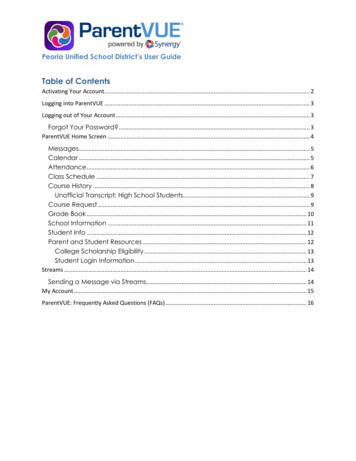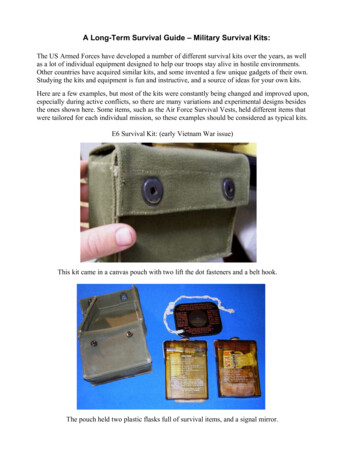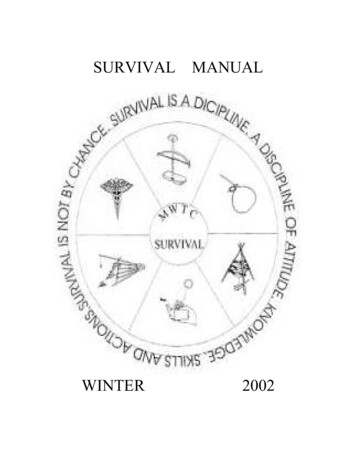
Transcription
The Unofficial JET Survival Handbook for 2005Compiled and reported by the Southeast Chapter of the JET Alumni AssociationStephen BurgeMary CollinsJessica CorkEdited by Theresa KanterJohn CrowMillie LinvilleChris MurphyKristina MurphyFiona Immonen SusieJennifer Wilson
Table of ContentsAlphabet Soup1Departure Sequence2Suggested Pre-Departure Preparations4Prescription Medication Information8Elementary Japanese 11Vowel SoundsGreetingsIntroducing YourselfUseful PhrasesSome Useful Expressions for VegetariansGift Giving in Japan: Arming yourself with Omiyage111111121415Living in Japan Sample Budgets Dealing With Culture Shock & Survival Strategies Japanese Food161923Life as a JET: Perspectives from Experience Life as a Vegetarian JETLife as a Gay JETLife as a Female JETLife as an African-American JETLife as an Asian American JET2528293032What to Expect on the Job The Environment of the Japanese Workplace34 CIRs36 ALTs38Computers & Internet43Recommended Reading, Links, and JETAA contact information47Map of Japan50Notes!51Special thanks to Dominique Eugene, Secretary, and Chris Padilla, President, at the Southern Californiachapter of JETAA for generously allowing us to use chapters from the JETAA-SC Pre-DepartureHandbook. Thanks also goes to the many contributors of this handbook, including Kevin Beck, NajwaWaheed Naohara, Jenny Wilson, & Brian Woodworth.54
Alphabet SoupAJET Association of Japan Exchange and Teaching Program participants. Joining is highlyadvisable, but optional. www.ajet.netALT Assistant Language Teacher. An umbrella name that includes AETs (Assistant EnglishTeachers), AFTs (Assistant French Teachers), AGTs (Assistant German Teachers), etc.CIR Coordinator for International Relations. Those JETs engaged in international activities.These participants are placed in offices of local governments or related organizations such asinternational associations, universities, convention bureaus and so on. CIRs rarely work inschools, but occasionally they may be called to teach or present in schools.CLAIR Council of Local Authorities for International Relations. CLAIR is the governing bodythat oversees the JET Program. CLAIR is also a sponsor of the JET Alumni Association.ESID Each Situation is Different. JETs are placed throughout Japan in a variety of settings(rural, urban, junior high school teacher, high school teacher, etc.) so that while it is possible toprovide some sense of what life is like for an individual JET, these experiences may not betransferable.JET Japan Exchange Teaching (Program). May also be used to refer to a participant of the JETProgram.JETAA Japan Exchange Teaching Alumni Association. We hope you’ll be a member post-JET.The International website is http://www.jetalumni.org/ and our chapter is www.jetaase.orgSEA Sports Exchange Advisor. These JETs promote international exchange through assistancein sports training and the planning sports related projects.SIG Special Interest Group. A smaller organization within AJET targeted to a specific group.For example: are geared towards women, gays and lesbians, JETs of Asian-/ African-/ LatinAmerican decent, and religious groups.1
Departure Sequence: What to Expect When you First Arrivein JapanArrival in Tokyo: July 24When you arrive at the New Tokyo International Airport in Narita, you will be greeted in thearrival lobby by CLAIR staff, Tokyo Orientation Assistants (current JET participants) and travelagent representatives. All arrival staff will be wearing JET t-shirts of the same color, and shouldbe very easy to spot. You will be directed to a shipping area where luggage can be forwarded toyour Contracting Organization. You may take one large piece of luggage (suitcase or rucksack)and one hand-held carry-on with you to the hotel for Tokyo Orientation. Any other luggagemust be forwarded to the Contracting Organization.If you have more than one piece of luggage, and the belongings you need for orientation aredivided among your bags, you will be required to repack on the spot. Please keep this in mindwhen packing for departure. After the baggage is shipped, you will transfer by charted bus to thearranged hotels in Tokyo. All participants must travel on the arranged buses as names arerecorded and essential information is provided by Tokyo Orientation assistants during the busride. Participants are NOT permitted to arrange alternative transportation. If you have peopleyou would like to meet while in Tokyo, ask them to meet you at your hotel, NOT at the airport.Post Arrival Orientation in Tokyo: July 25-26The Post-Arrival Orientation will be held in Tokyo. Attendance at the orientation ismandatory. The purpose of the Post-Arrival Orientation in Tokyo is to provide a basicintroduction to life on the JET Program. The Orientation includes:1. An introduction to the significance of the JET Program, presented by Japanesegovernment officials.2. An introduction to the positions and duties of JETs, presented by officials from theMinistry of Education, Culture, Sports, Science and Technology, the Ministry of PublicManagement, Home Affairs, Posts, Telecommunications, and CLAIR.3. Workshops including the job skills needed by JETs to fulfill their positions, conducted byTokyo Orientation Assistants, CLAIR, and selected professionals.2
4. Workshops and speeches introducing skills useful for daily life of JETs in Japan,conducted by Orientation Assistant, CLAIR Program Coordinators, and selectedprofessionals.5. A forum to meet other JETs, supervisors, and Tokyo Orientation Assistants representingtheir host prefectures where JETs can have specific questions about their locations,positions, and responsibilities answered.6. An opportunity for JETs to make physical (jet lag), mental and cultural adjustmentsbefore setting out for their assigned host prefectures and contracting organizations.Introduction to Host Institutions: July 27Each prefecture handles this a little differently, but essentially, a group of prefecturalrepresentatives will meet you in Tokyo at the Orientation and accompany you and the other newJETs to your prefecture. After arriving in the prefecture, you will be introduced to arepresentative from your host institution, and this representative will take you to your newapartment, an intermediary accommodation, the school, or the Board of Education. Althoughyou may be tired and jet-lagged, there will be many obligatory introductions in the first few daysof your arrival. First impressions are very important in Japan, so our advice is to try to make themost of this with your energy, enthusiasm, and wrinkle-free clothes!Most host institutions will have an apartment (or house) for you as soon as you arrive. You mayeither be placed in the apartment of your predecessor, or they will have chosen a new apartmentfor you. In some cases, a host institution will house the incoming JETs in a hotel the first fewdays or week, and you will be responsible for finding your own apartment with guidance fromyour host institution. In any case, preparations have been made to provide you housing.You have your house, you have your luggage, you are now ready to begin your life in Japan!3
Suggested Pre-Departure PreparationsIn the weeks ahead you’ll have lots to do to prepare for your upcoming year (years?!) in Japan onthe JET program. This section has a list of things to prepare for. While we have tried to think ofeverything, we can not certify this list as complete.Packing for One Year in Two SuitcasesWhile packing, please remember that you are limited to ONE carry-on and twosuitcases. Remember that one suitcase will be sent directly to your host institution upon arrivalat Narita Airport in Tokyo. It is suggested that you pack necessary items in your carry-on,should your bags become lost Protect clothes from leaks by placing toiletries in a plastic bag. Stuff socks and rolled-up belts into shoes to save space. Roll clothes to save space. Most clothes can be rolled to save space. Start withitems like jeans & put them in at the sides of the suitcase and then fill the insidewith smaller clothes such as T-shirts. Use space-saver bags (found at Linens andThings, Target, The Container Store etc.) for ultimate results! Pack a box of winter clothes and ship them by the cheapest way possible justbefore you leave in July/August. It may take a few months, but will allow formore room in your suitcase for warm-weather clothes, gifts, your CDs, yourpictures, and other items you might need more immediately in Japan. For thesake of comparison, a 20 pound box shipped by the U.S. Postal Service to Japanusing Economy (Surface) Post costs 40.Find someone to REALLY send you the things you need.Many people will offer lots of help, offering to send you anything you want or need, at the dropof a hat. While those are generous offers, they may not happen. We recommend that you findone person—not necessarily a family member—to really help you out. One approach is to give afriend your credit card to send stuff every month, and then treat him or her to dinner every timevia the card.Buy blank VHS tapes and ask a few well-chosen people to record your favorite TV shows.Prepare pre-addressed bubble envelopes (it’s quite the tease to get a damaged tape in the mail!)and give a friend or family member money for postage. The easier it is for those sending youstuff the more likely it is that you will receive it. I found that 10 tapes worked well.4
Make business card with your contact information in Japan before you go; pass them out.You can find a number of on-line companies that provide cards for free if you can tolerate theiradvertising printed on the reverse. This will make it easier for your friends to keep in touch.Legal/Financial Obligations to TakeCare of Before you Leave Power of Attorney Payment of bills W2 forms Creation of a will Magazine subscriptions canceled or diverted Mail order catalogs canceled or divertedImportant documents and 2500 - 3000 (ATM transactions provide the bestexchange rate, but traveler's checks also work well) A passport (preferably your own) Certificate of US Residency A photo copy of passport (one for home too) A plane ticket and folder for the return portion Contract from host institution, if received State Driver's License International Driver's License (available at AAA- good forone year) International Youth Hostel Card (available at most travelagencies) List of emergency phone numbersHygieneWhile a full complement of cosmetics and hygiene productsare generally available in Japan, you may not be able to getyour favorite brand. If you have a strong connection tospecific products or have special needs, pack extra or plan tohave someone send you care packages. Cosmetics Deodorant Toothpaste (with fluoride) & toothbrushes Complete toilet kit for visiting hot springs Condoms; spermicidal foam5
Products for African-American hair Tampons or sanitary napkinsClothingWhat to wear to work varies as widely as types of sushi inJapan! The best advice is to dress conservatively and moreformally for the first week of work. During this time, observewhat your peers (in age, gender, and position) are wearing,and adopt what you wear accordingly.Another concern is that the Japanese are a relatively petitepeople with small feet, so it may not be easy to shop locally.Check out the Links section for recommended on-line catalogsthat ship to Japan. Men: jacket, slacks, shirts, polo shirts, tie, black tie; whitetie Women: dresses, skirts, suits, blouses, sweater sets,scarves, hosiery Sportswear and casual school clothes Dress shoes, shoe trees (cedar will ward off mold), polishand laces School shoes (slip-on indoor school shoes indoor/outdoor sports shoes) Walking/hiking shoes, thick socks for hiking Underwear, bras (your size and style may not be availablein stores or boutiques) Rain jacket, poncho, galoshes, and/or Wellingtons Union suit or long johns for alpine JETsMedication Birth control pills(see page 8 for more details) Prescriptions (must have YOUR name on label) Vitamins or herbal supplements Doctor’s explanation for long term drugs (more than amonth)Teaching Materials Contact your local/state chamber of commerce or tourismbureau for videos and other materials about yourhometown. Self introduction materials (maps, brochures, pictures offamily & home)6
Holiday items e.g.; ornaments, cards Video of family/house/town if available Current American music Prizes for students (stickers, rubbers, stamps, coins, flagpins, pop star pins) Learn about your own junior/senior high schools.Other English/Japanese dictionary English/English dictionary Handbooks of English grammar Japanese guide books Camera Cookbooks (if you can’t cook, you’ll learn) Measuring cups & spoons (If you’re using anAmerican/English recipe, you’ll need measuring cupsbased on 1 cup 250 ml. A Japanese measuring cup is200 ml.7
Prescription Medication Info from the JET OfficeThe Japanese Customs department places strict restrictions on the amounts and types ofmedications and toiletries that can be brought into or sent to Japan. If you are planningto bring a supply of such products with you when you come, or are considering havingthem sent to you while you are in Japan, please read the following very carefully.Over-the Counter Medications:(Customs Limit: 2 month's supplyonly) Most things are available (certainly in the larger cities),though often at a higher price than at home. You onlyneed to bring brand items to which you are especiallyattached. Please be aware of Japanese customs restrictions.Medicines that are sold over the counter in your homecountry are illegal in Japan if they contain stimulants (i.emedicines containing Pseudophedrine such as Actifed,Sudafed and Vicks inhaler). Codeine is also illegal.Check the contents of cold, allergy, sinus, and painmedications extra carefully. Medications/antiperspirants, sanitary products, dentalproducts such as fluoride toothpaste and dental floss, etc.are restricted to 24 pieces per product.Prescription Medications: (Customs Bring unopened in original packaging.Limit: 1 month supply only) Bring a copy of the prescription. Bring a letter from your doctor stating the purpose of thedrugs. In principle, you can bring up to a month's supply. If youbring more, the medicine may be seized and you could becharged with intent to sell illegal substances. Once yoursupply has run out, take the prescription to a doctor inJapan. Comparable medication is available. Some associations such as the Epileptic Association ofAmerica have listings of comparable medications in Japanand medications that are legal for import. Bring extra copies of your prescription along with themedications' generic names. Even though foreignprescriptions cannot be filled, you will need to show themto your new doctor, so that he may help you find acomparable medication. Some prescription medications that are legal in yourcountry may be illegal for import to Japan. In this case,"importing" means to receive the medication while in8
Japan. Therefore, you can bring your own one-monthsupply with you, but cannot have more sent over later. Iffound, the medication will be confiscated and destroyed.Please check with Japanese customs to find out whetheryou medication is legal for import.Vitamins(Customs Limit: 4 months' supplyonly)Cosmetics(Customs Limit: 24 pieces per productonly)Sending MedicationsJapanese brands tend to be expensive, and often only basicvitamins/multivitamins are available. If there is a brand orparticular vitamin/mineral supplement that you insist ontaking, you should bring a 4 month supply with you and thenhave another 4 month supply sent when required.Japanese cosmetics tend to be expensive and often suited toAsian skin and hair. If you have a particular brand or productto which you are attached, you may wish to bring a smallamount to tide you over until you can find a suitablereplacement.The same rules apply to medications that are sent to JETsresiding in Japan. You may have medications sent, if it iswithin the limited amount (and a prescription is included withprescription medication). If you want to import more than thecustoms amount, you must apply for a certificate, providingdocuments 1-3 listed below, as well as an invoice/receipt, plusan Air Way Bill or notice from Japanese customs. If thecertificate is granted, it should be sent with the medication toJapan. Please remember that some medications are prohibitedfrom import, and will be destroyed by customs. Likewise, ifyou import more than the allowed limit, the remaining amountwill be confiscated and destroyed.NOTE: SHOULD YOU NEED TO BRING ANY MEDICATION IN EXCESS OF THEAMOUNTS STATED ABOVE, YOU WILL NEED TO APPLY DIRECTLY TO THEJAPANESE MINISTRY OF HEALTH, LABOR, AND WELFARE. Before bringing extra quantities of medications, you must first receive permission from theMinistry of Health, Labor and Welfare in the form of a "Yakkan Shomei" certificate. In order to apply, you will need the following documents (available from the Consulate)1. 2 signed copies of the Application form (Import of Medication)2. 1 signed copy of the Declaration3. Explanation of products4. Prescription for your medicine In addition to the above, JETs wishing to bring the medication to Japan with them will needsome kind of document indicating the date of arrival in Japan. If this is necessary, please9
contact the Consulate and we will provide you with a letter stating the date you will arrive inJapan. If there is any inconsistency in the application form, there is the possibility that the applicationwill be rejected. Therefore, please submit the application forms as clearly as possible. Please bear in mind that there is a chance that your application may be denied. Be sure to haveall your application paperwork in order, and be prepared to make alternative arrangements (suchas finding a comparable medicine in Japan), should your application be denied. Please submit your application as soon as possible directly to the Kantou-Shinetsu RegionalBureau of Health and Welfare:Section of Medicinal Inspection and GuidanceKantou-Shinetsu Regional Bureau of Health and WelfareMinistry of Health, Labour and WelfareSaitama-shintoshin-Godochosa 1, 7th Floor, 1-1 shintoshinChuo-ku, Saitama City, Saitama Prefecture, JAPAN 330-9713Tel: 81-48-740-0800 Fax: 81-48-601-133610
So, you're going to Japan.Nihongo ga wakarimasuka?!VOWEL SOUNDS IN JAPANESE:"A" sound as in father, Austria, coffee"I" sound as in peace, cheese, Tahiti"U" sound as food, blue, Yahoo!"E" sound as in pet, mental or polenta"0" sound as in ocean, ArizonaGREETINGS:Hajimemashite. It is nice to meet you.Dozo yoroshiku onegaishimasu. Please treat me well.Ohayo Gozaimasu. Good Morning. (this can be shortened to "Ohayo!" or, for young maleteachers, something like “oh’ss!” but be careful not to get too casual too quickly)Konnichiwa. Hello. (not used with the same frequency that hello is used in English)Konbanwa. Good Evening. (wait until it is well on its way to darkness before you use this one)Sayonara. Good-bye. (not used as often as in English—has a connotation of "until we meet again,"i.e., a significant parting)Ja, ne. or Mata ne. Bye-bye!! See you later. Bye. (Very casual and used a lot among friends.)Moshi, moshi. Hello. (For use on the telephone ONLY.)Oyasumi nasai. Good night. (Used just like in English either as good-bye at the end of theevening or as just plain old good night.)INTRODUCING YOURSELF:Master this self-introduction and you'll make a very favorable impression. Begin by bowing deeply,with your eyes downcast. Do not make too much eye contact.Minasan, hajimemashite. It is nice to meet all of you.Watashi wa (name) desu. I am (name).Amerika no (state) kara kimashita. I am from (state) in the USA.Dozo yoroshiku onegaishimasu.” Please treat me well.And if you are feeling adventurous, add the following to your self-intro right before the “dozo:”“Kono ichi nenkan o tanoshimi ni shite imasu.” (I am looking forward to the coming year.)11
USEFUL SET PHRASES IN JAPANESE: (you'll use and hear them countless times a day!)(Dozo yoroshiku) onegaishimasu. Literally, "I am humbling myself to seek your/ a favor".Many feel that no one set phrase in Japanese used more than this one. It conveys the underlyingcultural ideals of Japan more than any other. Often when we ask someone to help us in English, wefinish with “Thanks for taking care of this for me." In Japanese, "thanks!" will be replaced with an“onegaishimasu” phrased in varying levels of politeness and respect. You'll always be seeking thefavor of someone, from submitting your holiday request to asking for help at the photocopier.Daijobu desu. Literally, "it's alright." This is a great one. It can be used to describe how yourelate to anything from raw fish to Japanese squat toilets! It is used in the same multitude of waysthat it is used in English.Domo arigato gozaimasu./ Domo arigato./ Domo. Domo, domo. "Thank you." Like English,gratitude can be expressed in varying degrees-you'll just have to pay attention to the usages of thesewords. Arigato gozaimasu is usually sufficient.Ganbatte kudasai! It is translated into English as "good luck" but I think the literal translationconveys its meaning much more clearly—"please persevere, keep you chin up, try your best.”There is definitely more pressure on you when you are asked to ganbatte kudasai. You will beasked or told to ganbatte especially when you first get to Japan and to your new school. Theappropriate response is not thank you (as it would be in response to good luck) but.Gochisosama deshita. Literally, "it was a wonderful feast." Always use this after you finish ameal (even if you aren't a big fan of raw sea cucumber!)Hai, ganbarimasu! More casually, ganbaro! "Yes, I will do my best!" That's all they can ask ofyou, right? If you want to really impress your coworkers, the principal, your supervisor, etc., youcan say the following: isshokenmei ganbaritaito omoimasu. (I want to do my absolute best).Iie, kekko desu. Just in case you are not daijobu with the raw fish and pickled plums, wave yourhand gracefully in front of your face and say a very polite “no thank you,” "iie, kekko desu." Forthe sake of adventures in international living, use this only after you have given everything andeveryone a fair shake, the old "college try." That is the key to success, is it not?Itadakimasu. Literally, "I humbly accept this." Most often used like "Bon Appetit" before youbegin eating (but can also be used instead of/in addition to thank you when someone gives you apresent,Itte irrashai! Literally, "please go and come back" Shopkeepers most frequently use this phrase.12
Itte kimasu! Literally, "I am going and coming back." It is used when you leave the house or go torun an errand to a place like the post office from the school. Again, you don't use sayonara in thiscase-it's too final. Put everyone at ease and say “itte kimasu!” instead.Ki o tsukete kudasai. Basically, "take care of yourself/be careful." It is used when parting, muchin the same way it is used in English but has the connotation that you need to pay attention andavoid danger/trouble.Odaiji ni. “Get well” or “please take care of yourself." It is used when someone is sick.Ojama shimasu. Literally, "I am intruding." Used when entering someone's home as you take offyour shoes and step up into the home, acknowledging that you may have interrupted the family/hostess in some way by visiting- a formality.Okaeri nasai! Basically, "welcome home." You can figure out when to say this one, can't you?Yer mum.Osaki ni shitsurei shimasu. Basically, "I am leaving before you, forgive me for being rude." Youwill use this on your way out the door at the end of the day, most likely in conjunction with thephrase above, otsukaresama deshita because more than likely, you will leave school before yourfellow teachers." Osaki ni shitsurei shimasu. Otsukaresama deshita. (reversible)" I am sorry forbeing rude and leaving before you. Thanks for all of your hard work today. "Osaki ni by itself canbe used anytime you start to do something before someone else, such as begin to eat, go to bed,basically, or for when you think you might be inconveniencing someone else. Also, shitsureishimasu is often used as the final thing you say as you get off of the telephone with someone, i.e., avery polite good-bye.Otsukaresama deshita. Thank you for your hard work. This is often used instead of good-bye.When you leave your school at the end of the day, you will want to make sure that you say this toyour coworkers as a way to acknowledge that you have all completed a long day at work. Anotherusage is similar to hello. When you pass a fellow teacher in the hall you may very well useotsukaresama (by itself) instead of konnichiwa as a greeting to acknowledge the presence of theperson you are passing.Sumimasen. It can be used in three different ways: excuse me, thank you, and I am sorry. Youmay be familiar with the "excuse me” version of this word but you may not know the apologetic orgratitude forms of the word. Many are surprised when to find it used instead of “thank you” duringthose times when someone would bring me something like a cup of tea.Tadaima! Basically, "I’m home!" Used in family situations, perhaps for home stays.13
SOME USEFUL EXPRESSIONS FOR VEGETARIANS:Watashi wa niku o tabemasen. I do not eat meat.Watashi wa sakana igai ni niku o tabemasen. Except for fish, I do not eat meat.Watashi wa igakuteki na riyuu ni yori niku o taberaremasen. I cannot eat meat for medicalreasons.Watashi wa shukyoujyou no riyuu ni yori niku o taberaremasen. I cannot eat meat for religiousreasons.Watashi wa niku (sakana) ni arerugi ga arimasu. I am allergic to meat (fish).Kore ni **** haitte imasu ka. Does this contain ******** nashi de tsukuremasu ka. Can you make it without ****14
Gift Giving in Japan: Arming yourself with OmiyageOmiyage is the Japanese word for souvenirs or gifts. Gifts are often given to recognizethe importance of a relationship and to facilitate introductions. This gesture is notconsidered to be a form of bribery. Souvenirs are a much appreciated recognition that,while you were away having a good time overseas or elsewhere in Japan, others worked hard to“hold down the fort.” You will find your desk at times overflowing with sweet bean paste buns orcrackers.Take presents for key people who will be helping you: your principal and vice-principal, otheroffice staff, and of course the English teachers you will be working with. The value of the giftshould correspond to the rank of the recipient or the importance of the role they will play in yourdaily or working life. This calculation is an art and not a science. Your thoughtfulness is whatmatters most. Gifts that bear an emblem of your home state or a local sports team are particularlygood.Finally, you may want to take small, extra gifts for neighbors and others who may becomeimportant in your daily life. A traditional gift for neighbors is a tea towel or hand-cloth. SomeJETs have taken souvenirs of their hometown (pins, postcards, and key chains), pens and liquor.The possibilities are endless. Pencils, stickers and other small items are useful as rewards forclassroom games. An affordable place to get lots of giveaways is the 1 Store!15
Living in JapanTHE JET’S BUDGET Of course, ESID (Every Situation Is Different), so every budget will be different. The following isan anecdotal account of some JETs’ budgets just to give you an idea. (n/a info. not available)CategoryInaka (rural)SuburbanUrbanRentfree 20,500 60,000Waterfree 1,600 2,000Electricityfree 3,500 3,000 (more in winter)Natural Gasfree 3,500 4,000Kerosenen/a 2,500 (only in winter) n/aNewspapers, cable, etc 10,000n/an/aDomestic Phonefree (up to 10,000) 15,000 (lotta internet) 11,000International Phone 15,000 9,000 (use callback) 0 (email instead)School Lunchn/a 7,000n/aGroceries 9,000 12,500 15,000Car Insurancefree 5,300 15,000Parkingfree 10,000 15,000Gasoline 6,000 2,000 (lotta walking)n/aEntertainment 5,000 (nothing to do) 20,000 30,000Cell Phone 4,000 (no usage)n/a 8,000Savings 70,000 easy 120,000 30,000 (scrimping)Notes from Allison (suburban):The first thing I do on payday is head to the post office and send a money order home. I find that if Idon't do this end up spending what I should be saving. I usually send a lot of money home at thebeginning of the month so by the end of the month, I don't have much left, but it is not a problem. Ican do without many things here because my priority is getting my money back home. I find that Ican get by on very little if I need to—a skill developed in my university days! JETAA-SC16
I also save any "bonus" money I receive-so if I get a refund for school lunch, travel expenses, etc. Idon't spend it, even if it is only a couple hundred yen. I use this money to fund things likevacations. It makes a big difference. I also find that if I keep track of how much each bill was eachmonth, it makes me more conscious of ways I can cut corners. So if the phone bill was a littlehigher than it should be, I try to be a little bit more conservative with my phone time and onlinetime.I have been able to travel, despite my savings priority. On the months I do travel, I don't send asmuch money home. I have traveled a lot in a year and a half. I went back to Canada twice (and willgo back home this summer, too), and I went to the Philippines and Thailand. I have also been on afew spending sprees in Tokyo. I bought a car recently (160,000) too.So, depending on your lifestyle, in combination with where you live, it is possible for some to savea lot and still have fun too. I recommend that if you are really serious about saving, start sendingmoney home after your first paycheck and then do it every month on payday. Make it a habit. Getus
The Unofficial JET Survival Handbook for 2005 Compiled and reported by the Southeast Chapter of the JET Alumni Association Edited by Theresa Kanter Stephen Burge Mary Collins Jessica Cork John Crow Millie Linville Chris Murphy










